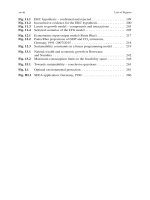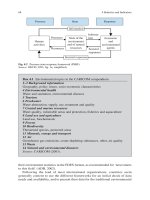Honest signals how they shape our world
Bạn đang xem bản rút gọn của tài liệu. Xem và tải ngay bản đầy đủ của tài liệu tại đây (643.94 KB, 205 trang )
Bob Metcalfe, 3Com founder, Ethernet inventor,
and National Technology Medalist
ÒSandy Pentland, always ahead of everyone, has captured
in this snappy and well-written book, the deep signals we
use to communicate and how they shape and reveal our
social behavior. A must-read.Ó
Michael S. Gazzaniga, Director, Sage Center for the Study of
Mind, University of California, Santa Barbara
THE MIT PRESS
978-0-262-16256-2
HOW THEY SHAPE OUR WORLD
PENTLAND
MASSACHUSETTS INSTITUTE OF TECHNOLOGY
Award citation, Future of Health Technology Institute, 2008
H O N E ST
S G NALS
ALEX (SANDY) PENTLAND
ÒA technology poised to change the world.Ó
Technology Review
H O N E ST
S G NALS
H O W T H E Y S H A P E O U R WO R LD
ALEX (SANDY) PENTLAND
How can you know when someone is blufÞng? Paying attention? Genuinely interested? The answer, writes Sandy Pentland
in Honest Signals, is that subtle patterns in how we interact
with other people reveal our attitudes toward them. These
unconscious social signals are not just a back channel or a
complement to our conscious language; they form a separate
communication network. Biologically based Òhonest signaling,Ó evolved from ancient primate signaling mechanisms,
offers an unmatched window into our intentions, goals, and
values. If we understand this ancient channel of communication, Pentland claims, we can accurately predict the outcomes
of situations ranging from job interviews to Þrst dates.
Pentland, an MIT professor, has used a specially designed
digital sensor worn like an ID badgeÑa ÒsociometerÓÑto
monitor and analyze the back-and-forth patterns of signaling
among groups of people. He and his researchers found that
this second channel of communication, revolving not around
words but around social relations, profoundly inßuences major
decisions in our livesÑeven though we are largely unaware
of it. Pentland presents the scientiÞc background necessary
for understanding this form of communication, applies it to
examples of group behavior in real organizations, and shows
how by ÒreadingÓ our social networks we can become more
successful at pitching an idea, getting a job, or closing a deal.
Using this Ònetwork intelligenceÓ theory of social signaling,
Pentland describes how we can harness the intelligence of
our social network to become better managers, workers, and
communicators.
MD DALIM 975843 7/26/08 YELLOW ORANGE BLUE
ÒPentlandÕs work truly improves the human condition and
revolutionizes the way we live and relate to one another.Ó
CAMBRIDGE, MASSACHUSETTS 02142
ÒPeople are communicating more now than ever before,
and we frequently joke about how great it would be to
simply turn off our cell phones. Well, you should, for at
least as long as it takes to read Sandy PentlandÕs Honest
Signals. Sociometers are now gathering early data on the
dominance of our nonlinguistic communications and their
importance in increasing our Ônetwork intelligence.Õ This
book will help shape the future of communication.Ó
H O N E ST S G NALS
Professor Alex (Sandy) Pentland is a leading Þgure at the
MIT Media Lab and is a pioneer in the fields of organizational engineering, mobile information systems, and
computational social science. He codirects the Digital Life
Consortium, a group of more than twenty multinational
corporations exploring new ways to innovate, and oversees the Next Billion Network, established to support
aspiring entrepreneurs in emerging markets. In 1997,
Newsweek magazine named him one of the 100 Americans
likely to shape this century.
H T T P : / / M I T P R E S S . M I T. E D U
cognitive science/business
HONEST SIGNALS
HONEST SIGNALS
How They Shape Our World
ALEX (SANDY) PENTLAND
with
TRACY HEIBECK
A Bradford Book
The MIT Press
Cambridge, Massachusetts
London, England
© 2008 Massachusetts Institute of Technology
All rights reserved. No part of this book may be reproduced in any form by
any electronic or mechanical means (including photocopying, recording, or
information storage and retrieval) without permission in writing from the
publisher.
MIT Press books may be purchased at special quantity discounts for business or sales promotional use. For information, please email
Press, 55 Hayward Street, Cambridge, MA 02142.
This book was set in Scala and Scala Sans by SNP Best-set Typesetter Ltd.,
Hong Kong and was printed and bound in United States of America.
Library of Congress Cataloging-in-Publication Data
Pentland, Alex (Sandy).
Honest signals : how they shape our world / Alex (Sandy) Pentland.
p. cm.
Includes bibliographical references and index.
ISBN 978-0-262-16256-2 (hardcover : alk. paper)
1. Social perception. 2. Organizational behavior. 3. Business networks.
4. Social interaction. I. Title.
HM1041.P464 2008
302′.12—dc22
2008013832
10
9
8
7
6
5
4
3
2
1
CONTENTS
Preface: A God’s Eye View
vii
Acknowledgments
xvii
1
HONEST SIGNALS
1
2
SOCIAL ROLES
3
READING PEOPLE
4
SURVIVAL SIGNALS
5
NETWORK INTELLIGENCE
6
SENSIBLE ORGANIZATIONS
7
SENSIBLE SOCIETIES
21
33
45
85
v
57
71
CONTENTS
Epilogue: Technology and Society
95
Appendix A: Social Science Background
Appendix B: Success
113
127
Appendix C: Connecting
Appendix D: Social Circuits
135
Appendix E: Unconscious Intelligence
Notes
151
References
Index
99
165
179
vi
145
PREFACE: A GOD’S EYE VIEW
The group of rising-star business executives gathered at MIT for an
important task: each executive would present a business plan to the
group, and then the group would choose the best ideas to recommend to a team of venture finance experts. It was a great opportunity. The skills they each required—the ability to clearly formulate
ideas, effectively communicate to a group of peers, and then persuade others to pursue those ideas—are indispensable in business
as well as everyday life. These executives had each spent more than
a decade building their strengths.
Not only the other group members were watching and evaluating
the business plan pitches, however. A sensitive, specially designed
digital device was also monitoring each presentation. This device—
we’ll call it a sociometer—wasn’t recording what each person said in
their presentation but rather how they said it.1 How much variability was in the speech of the presenter? How active were they
vii
PREFACE
physically? How many back-and-forth gestures such as smiles and
head nods occurred between the presenter and the listeners? This
device was measuring another channel of communication that
works without spoken language: our social sense.
At the end of the meeting, the group selected the ideas that they
agreed would sell the best. At least that is what they thought. When
the venture finance experts were given the plans to evaluate—this
time on paper, rather than via a live presentation—there was little
similarity between the two groups’ judgments. Each group had a
different opinion of which business plans were most likely to
succeed. Why?
Our up-and-coming executives didn’t pick different business
plans simply because they weren’t as seasoned as the venture
finance experts. Remember our other observer in the room—the
sociometer? As it turns out, the sociometer was able to predict
which business plans the executives would choose with nearly
perfect accuracy. Both the sociometer and our executives (even
though they didn’t know it at the time) were busy measuring the
social content of the presentations, quite apart from the spoken,
informational part.2 And which channel of communication—social
or spoken—informed more of their final decision? Yes, the social
channel.
The executives thought they were evaluating the plans based on
rational measures, such as: How original is this idea? How does it
fit the current market? How well developed is this plan? While listening to the pitches, though, another part of their brain was registering other crucial information, such as: How much does this
person believe in this idea? How confident are they when speaking?
How determined are they to make this work? And the second set
viii
PREFACE
of information—information that the business executives didn’t
even know they were assessing—is what influenced their choice of
business plans to the greatest degree.
When the venture finance experts saw the business plans,
however, this social channel of communication was purposely
removed. They saw the plans written on paper only—with no live
presentation. With the social sense disconnected from the decision,
the venture finance experts had to evaluate the plans based on
rational measures alone. Unfortunately for them, research has
shown that investments made without that “personal connection”
are far more likely to fail.3 This is why venture capital firms normally only invest in companies they can visit regularly in person,
and why many investors pay more attention to the face-to-face
interaction among the company’s founders than they do to the
business plan itself.
This study, along with many others, leads us to a surprising yet
illuminating conclusion: people have a second channel of communication that revolves not around words but around social relations.
This social channel profoundly influences major decisions in our
lives even though we are largely unaware of it.4 This idea lies at the
heart of this book. My goal is to show you how powerful and pervasive this form of communication is in our daily lives, how it changes
the way we think of ourselves and our organizations, and how you
can make use of this information to better manage your life.
WHAT THIS BOOK IS ABOUT
Honest Signals comes from a new and emerging science, called
network science, that tries to understand people in the context of their
ix
PREFACE
social networks rather than viewing them as isolated individuals.
Historically, our understanding of human society has been limited
to relatively sparse observations of individuals or small groups
because we have had only simple measurement tools. Recent
advances in wireless communications and digital sensors have
made it now possible to observe natural, everyday human behavior
at a level of detail that was previously unattainable. The result has
been revolutionary measurement tools, such as the sociometer
mentioned above, that provide us with a “God’s eye” view of
ourselves.5
For the first time, we can precisely map the behavior of large
numbers of people as they go about their normal lives. By using
cell phones and electronic badges with integrated sensors, my students and I have observed hundreds of participants for periods of
up to a year. In the process we amassed hundreds of thousands of
hours of detailed, quantitative data about natural, day-to-day human
behavior—far more data of these kind than have ever been available
before.6
A new measurement tool such as this often brings with it a new
understanding of what you are measuring. What we have found is
that many types of human behavior can be reliably predicted from
biologically based honest signaling behaviors. These ancient primate
signaling mechanisms, such as the amount of synchrony, mimicry,
activity, and emphasis, form an unconscious channel of communication between people—a channel almost unexplored except in other
apes.7
These social signals are not just a back channel or complement
to our conscious language; they form a separate communication
network that powerfully influences our behavior. In fact, these
x
PREFACE
honest signals provide a quite effective window into our intentions,
goals, and values. By examining this ancient channel of communication, for instance—paying no attention to words or even who the
people are—we can accurately predict outcomes of dating situations,
job interviews, and even salary negotiations.8
We have shown that people’s behavior is much more a function
of their social network than anyone has previously imagined.
Humans are truly social animals, where individuals are best likened
to musicians in a jazz quartet, forming a web of unconscious reactions tuned to exactly complement the others in the group. What the
sociometer data demonstrate is that this immersion of self in the
surrounding social network is the typical human condition, rather
than being isolated examples found in exceptional circumstances.
Why does this ancient communication channel exist? What does
it do? Data from biology show that honest signals evolved to
co-ordinate behavior between competing groups of individuals.9
For instance, honest signals form a communication channel that
helps to create family groups and hunting teams. The social
circuits formed by the back-and-forth pattern of signaling between
people shapes much of our behavior, as our ancient reflexes for
unconscious, social coordination work to fuse us together into a
co-ordinated (but often contentious) whole.
In a family, a work group, or even an entire organization, the
pattern of signaling within the social network strongly influences
the behavior of both the individuals and the group as a whole.10
Healthy signaling patterns result in good decision making, while
bad patterns result in disaster. The social circuitry of a work group,
for instance, can insulate the group from problems like groupthink
and polarization. Even for large networks of humans, such as
xi
PREFACE
companies or entire societies, the pattern of social circuitry influences the “intelligence” of the network.
By paying careful attention to the pattern of signaling within a
social network, we can harvest tacit knowledge that is spread across
all of the individual members of the network. This network intelligence approach to capturing the “wisdom of the crowd” produces
surprisingly good results and is often many times better than traditional decision-making methods. I will examine this idea of
network intelligence carefully, and see how to harness it to improve
group decision making.
PLAN FOR THE BOOK
The goal of this book is to show how these honest signals influence
critical activities such as negotiation, group decision making, and
project management, and to demonstrate how powerful and pervasive this form of communication is in our lives. Throughout, I will
present new science backing many intuitive ideas that were previously thought to be just folk wisdom. By refining these intuitions
with scientific measurements and explanatory mechanisms, readers
will discover a new and powerful way to understand and manage
human groups, corporations, and even entire societies.
The first order of business will be to explain how social circuits
work, and how to be more aware of them. Drawing from research
into animal behavior, we find that animals communicate by signals,
with honest signals being of particular interest. Honest signals are
behaviors that are so expensive or so directly connected to the
underlying biology that they become reliable indicators that others
use to guide their own behavior. People possess these same signals
xii
PREFACE
in addition to conscious language. They are so essential for people,
in fact, that infants rely on these signals in order to learn language.
Even from the beginning, our two channels of communication—
social and linguistic—are intertwined.
A startling finding is that the social circuits formed by back-andforth signaling between people is a major factor in even the most
important decisions in our lives. Using the sociometer mentioned
earlier, we will see that in many situations—including negotiation,
sales, dating, and teamwork—people’s signaling can accurately
predict how they are going to act and what the eventual outcome
will be.
Some people are experts at reading these social signals and using
them to influence others, even though most are unaware of how
they do it. We can begin to understand how they manage this by
examining how social signaling can be used to control behavior. By
looking at characteristic types of social tasks—such as pitching a
new idea, networking, and closing a deal—we find that particular
kinds of signals are associated with success. We can also see how
to change our personal style to become more effective.
The same social circuits that form between pairs of people are also
active in groups. By examining the signaling of groups making
various types of decisions, I will show how signaling works to shape
the behavior of human social groups. By comparing the performance
of groups with different patterns of signaling, I will demonstrate how
some patterns of signaling improve the decision-making capacity of
groups and aid the flow of information within our social networks.
We will see that the ability to “read” the social signaling within
one’s social network provides a mechanism for group decision
making that is different than the standard theory of rational
xiii
PREFACE
decision making. Instead of logic or argument, this is a marketlike
mechanism that aggregates information and minimizes risk to
achieve maximum expected results. The behavior of groups, organizations, and entire cultures can be analyzed in terms of this new
network intelligence theory of rational decision making. By looking
at examples of real organizations, we will gain surprising insights
and practical methods for managing and governing ourselves.
Finally, the book will look to the future, where digital tools like the
sociometer may become common in everyday life. The futuristic
capability to read the social side of life can revolutionize how we live
as well as how we manage ourselves. It can let us screen for depression, x-ray an organization’s health, or allow a company to “tune”
itself to maximize employee happiness. It could even be forged into
a new sort of nervous system that could span all of humanity. At the
same time, these new technologies present unprecedented threats
to privacy and social liberty, and so must be carefully used and controlled. The debate about how to harness this new human nervous
system is one of the most important going on today.
READING HONEST SIGNALS
Honest Signals is written to be accessible to a broad audience, not
just managers and academics, but also anyone curious about how
new science might change their lives. As a consequence, experimental details, statistical analysis, and examination of the academic
literature have been confined to the appendixes of the book.
Don’t assume, however, that these appendixes are purely academic, because they also provide detail useful for applying this
information in everyday life. The appendixes are:
xiv
PREFACE
Social science background The social science background, the
sociometer, and an explanation of the experimental and analysis
methods
Succeeding Assessing interest, pitching business plans, selling,
negotiation, and deception
Connecting Getting hired, getting a date, and social networking
Social circuits Understanding identity, work groups, friends,
and your position in the network
Unconscious intelligence A new understanding about how our
minds work gives hope that we can act with greater intelligence
■
■
■
■
■
In addition to the summary descriptions in the appendixes, there
are the original papers, theses, experimental data, and computer
codes available at <>.
Because of the large number of coauthors and papers summarized in this book, it proved difficult to name each coauthor and
paper in the main text and still maintain an ease of readability.
Consequently my research group will just be referred to as “we,”
but will be accompanied by a specific citation. Members of my
research group include current and former graduate students:
Sumit Basu, Ron Caneel, David Chilongo, Tanzeem Choudhury,
Brian Clarkson, Wen Dong, Nathan Eagle, Jon Gips, Taemie Kim,
Anmol Madan, Akshay Mohan, Daniel Olguin, Will Stoltzman,
Mike Sung, and Ben Waber as well as postdoctoral, adjunct, and
visiting researchers Koji Ara, Joost Bonsen, and M. C. Martin.
xv
ACKNOWLEDGMENTS
I am deeply indebted to my current and former graduate students,
postdoctoral, adjunct, and visiting researchers. I would also like
to thank my research collaborators for their support and help in
framing the ideas in this book, especially Jared Curhan, David
Lazer, Carl Marci, Deb Roy, and Dr. Yano. Finally, I would like to
thank Tracy Heibeck for her hard work at brainstorming examples,
editing the manuscript, writing some of the stories introducing the
chapters, and putting up with me while I worked to pull years of
research into a coherent narrative. Like Ginger Rogers, she danced
every step of writing this book, although it was not usually
backward.
xvii
HONEST SIGNALS
1
HONEST SIGNALS
It is just past dinner as you enter the local pub and find it filled
with separate clusters of twenty-something men and twentysomething women. Everyone appears both a little nervous and a
little excited—welcome to the world of speed dating. During the
next hour, each man and woman will spend five minutes chatting
with ten members of the opposite sex. At the end of every encounter, each person secretly writes down whether or not they want to
exchange phone numbers. If both say yes, then the organizers will
pass on the numbers at the end of the night.
Now, the common assumption is that men are fairly indiscriminate in situations such as this—they will say yes to almost any
woman—whereas women are far more selective. But tonight the
common assumption about men was wrong. As it turned out, men
generally said yes to exchanging phone numbers only when the
women also said yes.1 Remember, the rules of speed dating require
1
CHAPTER 1
that this information is kept secret and is seen only by the organizers at the end of the evening. So how did these men know, in just
five minutes, when the women they were talking with would say
yes? Was it a kind of mysterious chemistry? Was there some sort
of secret signal that tipped them off?
Perhaps biology, rather than chemistry, holds part of the answer.
Consider the concept of an honest signal. These are signals, as
noted earlier, that are either so costly to make or so difficult to suppress that they are reliable in signaling intention.2 A classic example
is the squawking made by hungry baby birds. When their parent
returns to the nest with some food, the fledglings immediately
launch into a chorus of loud cries. On the one hand, the cries make
the fledglings more vulnerable to nearby predators. On the other
hand, the benefit of signaling hunger to a parent outweighs the
increased risk from hawks and other enemies.
The potential costs associated with honest signals aren’t restricted
to predators. Some animals, such as the male peacock with its
extravagant feathers, assume a high metabolic cost for their honest
signals. Other large expenditures could be in energy, as typified by
many animals’ mating displays. Consider the exhausting strategies
of the male orangutan: he will shake branches, topple over dead
trees, and make calls loud enough to be heard for several miles. For
female orangutans, bigger seems to be better; the louder the male’s
calls, the more alluring they are for the female.
These trustworthy signals tend to evolve by natural selection
whenever the fitness of a species requires bringing together individuals in the midst of broad competition. The so-called battle of
the sexes is an example, and obviously the fitness of the species
depends on creating mating pairs. All of which brings us back to
2
HONEST SIGNALS
our speed-dating experiment. Our twenty-something women were
not in the trees shaking branches but were still sending signals of
some kind. The honest signals of humans are not quite so loud
and obvious, yet the trained eye—or sociometer—can detect them
easily. So could our twenty-something men. What did they see?
Imagine that you are watching two women from across the room
as they each converse with their speed dates. From your vantage
point, you can’t hear what they are saying but you can see all their
movements. One woman seems to be rather talkative, gesturing
and moving around as she speaks. You notice that she seems to
nod her head quite a bit, often in concert with the man at her table.
The other woman, however, does not seem to be doing any of these
things. She is rather still, appears to say just a few words, and there
is almost no back-and-forth gesturing between her and her date.
Based on these descriptions, who is having the better time with her
date? Who is going to say yes to exchanging phone numbers?
Chances are, you are as good at figuring this out as the men in the
speed-dating experiment were.
WHAT ARE HONEST HUMAN SIGNALS?
What are the types of honest signals that humans use? We are
familiar with many types of human signals; smiles, frowns, fast
cars, and fancy clothes are all signals of who we are (or who we
want to be). In fact, this sort of signaling is probably the basis of
fashion and “current culture.”3 We are conscious of these types of
displays and often carefully plan to incorporate them into our communications. And therein lies the problem: because these signals
are so frequently planned, we cannot rely on them being honest
3
CHAPTER 1
signals. We need to look for signals that are processed unconsciously,
or that are otherwise uncontrollable, before we can count them as
honest.
If we watch the give-and-take of conversational turn taking and
gesturing, and carefully measure the timing, energy, and variability
of the interaction, we can find several examples of honest signals.
Four that we will concentrate on here are:
Influence The amount of influence each person has on another
in a social interaction. Influence is measured by the extent to which
one person causes the other person’s pattern of speaking to match
their own pattern.
Mimicry The reflexive copying of one person by another during
a conversation, resulting in an unconscious back-and-forth trading
of smiles, interjections, and head nodding during a conversation.
Activity Increased activity levels normally indicate interest and
excitement, as seen in the connection between the activity level and
excitement in children, or when male orangutans shake branches
in order to impress potential mates.
Consistency When there are many different thoughts or emotions going on in your mind at the same time, your speech and
even your movements become jerky, unevenly accented and paced.
The consistency of emphasis and timing is a signal of mental focus,
while greater variability may signal an openness to influence from
others.
■
■
■
■
Each of these signals has its roots in our brain structure and
biology. This may be why they are such reliable signals of our behavioral tendencies. Our influence measure, for instance, provides an
4









